Anne Askew’s life (c. 1521-1546) was one of many made famous by John Foxe in his book of Martyrs in 1563, though at the time of her death in 1546 the crowd that came to see her was so large that it had to be forced back to make space for her to burn. In Victorian times he once again became a household name. Her story has many strands; the evangelical martyr, the renaissance writer, the woman who refused to submit to the rules of her day, and the innocent victim of vicious Tudor politics. For two podcasts which (in part) cover Anne’s life go to the History of England episodes 250 and 251.
Early life
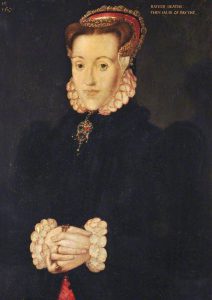 Near Glorious Grimsby lived a knight called William Askew, married to Elizabeth Wrottesley. William and Elizabeth were the proud parents of 5 – 2 boys and 3 girls. In about 1521, they christened their second girl Anne. There was great excitement when Anne eldest sister Martha was betrothed to be married to one Master Kyme, but in 1536, disaster struck and Martha died. To Anne’s dismay, they offered Anne as a substitute. Anne unwillingly did her duty, and she and Master Kyme had two children together. But all was not well in their household.
Near Glorious Grimsby lived a knight called William Askew, married to Elizabeth Wrottesley. William and Elizabeth were the proud parents of 5 – 2 boys and 3 girls. In about 1521, they christened their second girl Anne. There was great excitement when Anne eldest sister Martha was betrothed to be married to one Master Kyme, but in 1536, disaster struck and Martha died. To Anne’s dismay, they offered Anne as a substitute. Anne unwillingly did her duty, and she and Master Kyme had two children together. But all was not well in their household.
Anne had been relatively well educated, and could certainly read, and so she read, and she read the Bible. And what she read their turned her mind to the teachings of evangelicals. Anne was not of the shy and retiring type, she shared her views with her neighbours and husband. Neither were happy with her talk – Lincolnshire was a conservative place, and would be at the centre of the pilgrimage of Grace. When Anne proposed to the glittering cosmopolis that was Lincoln to see the bible there, they made their outrage known to the Bishop. Anne later related that:
For my friends told me, if I did come to Lincoln, the priests would assault me and put me to great trouble, as thereof they had made their boast
Anne was not intimidated one bit, and would not be cowed. There in the Cathedral she quietly read their bible – though the Act in Advancement of Religion in 1543 had laid down that women should only read the bible in private. The Cathedral staff frankly ducked the challenge – only one priest had a go, and Anne later claimed to have been so unimpressed that she couldn’t remember what he said.
Seeking a divorce
For Master Kyme, Anne rebellion was too much – and he threw his wife out. Anne responded by demanding a divorce; of her two children, by the way there is no sign, so it may be they died in infancy. Anne had no hope of gaining a divorce from the Bishop of Lincoln, and so she took herself to London, to the court of Chancery where she might have a better chance. She was a well connected noblewoman; her brother Edward was cup-bearer to the king, and her half-brother Christopher had been a gentleman of the privy chamber. Edward had served Archbishop Cranmer; and critically Anne’s sister Jane was married to George St Poll, a lawyer in the service of the duke and duchess of Suffolk, Catherine Willoughby, a member of the Queen’s household. This connection to the queen’s household would have consequences.
Into trouble for her religious views
But Anne attracted attention in London and it was probably March 1545 when she first got into trouble. She was hauled in front of the Bishop of London Edmund Bonner and interrogated. Eventually Bonner went away and wrote a document, a confession of faith and demanded she agree to it. Anne’s statement though was equivocal: “I Anne Askew do believe all manner of things contained in the faith of the Catholic church”.
This sounds innocuous enough, but Anne had managed to distance herself from the Roman church, and claimed the proper catholic church was of her own, the reformers. But for now, Anne was released as her family and connections fought her cause. In June 1545 Anne Askew was arraigned again before a jury for denying the mass; but no witness came forward and so the jury released her.
Innocent victim of politics
That might have been the end of the matter. However, someone noticed Anne’s connections to the Queen’s household. The religious conservatives on the king’s Council
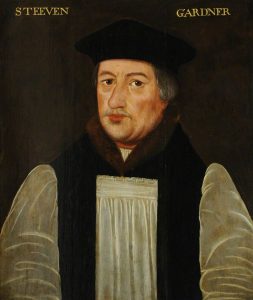
were determined to bring down Queen Catherine (Parr), whose evangelical household legitimized support for reform at court. Maybe Anne could be used to incriminate the Queen herself.
In May 1546, Thomas Kyme and his ‘wife’ were commanded to attend the king’s council at Greenwich on 19th June 1546. Anne refused to admit that Kyme was her husband – and probably much to his relief he was sent away. For two days Anne was interrogated by Councillors that included 3 of the leading religious conservatives – the chancellor, Thomas Wriothesley; Stephen Gardiner, bishop of Winchester; William Paget, the king’s principal secretary.
Anne answered, parried and on occasion flatly refused to answer their questions. She threw her knowledge of the scriptures at the Council’s collective head. Gardiner tried to charm her – he was her friend, he said, he only wanted to save her soul. Anne firmly and contemptuously pushed this away; these were the kind of weasel words of Judas she spat. The Council got nowhere, neither in persuading her that she was in error, or in eliciting any names. Time and again they pressed her about her connection to the Countess of Hertford, Lady Denny, the Duchess of Suffolk – all women of Catherine Parr’s household. Eventually the Council gave up. The recorder of the session concluded wearily that
‘seeing no persuasion of good reason could take place, she was sent to Newgate, to remain there to answer to the law.’
In Newgate prison, Anne started writing of her experience, and composing her ballad (which is below). But her ordeal had only just started.
Interrogation and execution
By the end of June, was arraigned for heresy at the Guildhall. She could have backed down and abjured avoided execution, but she would not. She flatly rejected the existence of any priestly miracle in the eucharist:
“As for that ye call your God, it is a piece of bread. For a more proof thereof… let it but lie in the box three months and it will be mouldy.”
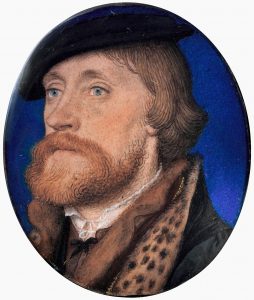
But Stephen Gardiner, Thomas Wriothesley, and Richard Rich were no less determined to break Anne, to get the information they needed to bring down the Queen and secure England’s future for traditional religion. Anne was taken secretly to the Tower. Gardiner ordered Kingston, the Constable of the Tower to have Anne racked. Extraordinarily, two members of the Privy Council took part in this by hand. Wriothesley and Rich met her there, and again pressed her for her connections at court, and in the presence of Anthony Kingston, they threatened her with the rack. This was quite illegal; torture was not allowed for anyone under the legal process without express permission of the king; noblemen were protected and it was unthinkable to torture a woman. Still Anne would not yield.
Essentially, Wriothesley and Rich ordered Kingston to put Anne to the rack. She as stripped to her shift, and she climbed onto the rack and was tied, hands and feet and the wheel turned to tighten the ropes. Anthony Kingston was clearly horrified, and once again Anne refused to talk. So Wriothesley and Rich demanded she be racked again, and much harder. This was too much for Kingston. He refused to be involved any further, and according to some accounts rushed off to try and get access to the king.
And so the Lord Chancellor of England, Thomas Wriothesley, and the Chancellor of the Court of Augmentations Richard Rich, both members of the King’s Council put aside their robes and put their own hands to the wheel. And they racked her. In Anne’s own words:
“Then they did put me on the rack, because I confessed no ladies or gentlemen, to be of my opinion… the Lord Chancellor and Master Rich took pains to rack me with their own hands, till I was nearly dead. I fainted… and then they recovered me again.
Still Anne would not tell them what they wanted to know. She would admit that some men had come to give her some money in prison to help her, and that they had said they’d come from Lady Denny and Countess Hertford, but that was all. It wasn’t enough for the Conservatives to build a case. Wriothesley and Rich despaired but still could not accept defeat. Here is Anne again:
After that I sat two long hours arguing with the Lord Chancellor, upon the bare floor… With many flattering words, he tried to persuade me to leave my opinion… I said that I would rather die than break my faith.”
Wriothesley and Rich were beaten. Anne was taken quietly and secretly to a private house to recover from her torture – but the violence visited on her body was too hideous, her joints were dislocated, she could not walk. Rich and Wriothesley had to face the music of the Council, horrified at what had been done – but the kind of music we are talking about here is a good old traditional establishment cover up. Not even in that could they succeed and news got out; a London merchant called Ottiwell Johnson, wrote to his brother that Askew remained
‘in steadfast mind, and yet she hath been racked since her condemnation’
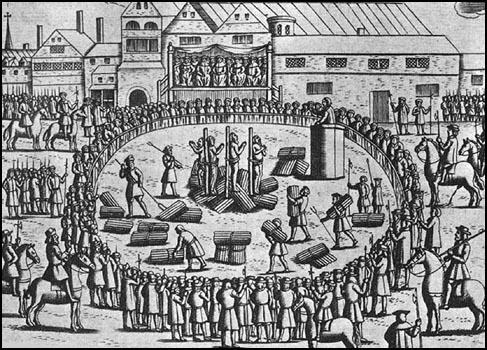
In agony in the secret house, Anne was once more given a chance to recant, and once more refused, and was returned to Newgate, there to write her story. The date for her execution was set as 12th July 1546. She would not die alone – three others, John Lascelles, John Hadlam, and John Hemley were also to be burned. There was a huge crowd, and both Wriothesley and Norfolk were there to see all was done. All three men were tied to stakes with faggots around them as normal, but Anne’s case was different – she was too broken to walk. Pushing through the crowd and the noise came the serjeants, bringing between them a chair on which Anne was carried. She could not stand at the stake to be burned, and so a small chair was set at the bottom of the stake and she was tied by ankles, wrist, chest and neck to the stake where she sat. Then through the crowd came her torturer Thomas Wriothesley, and he cried out that they could still recant and be pardoned. Anne replied for them all that when she replied that she ‘came not hither to deny my Lord and Master!’.
There are alternative views on how merciful was Anne’s death. Some accounts say that a small barrel of gunpowder was used to speed things up, and a barrel of gunpowder will do that for you, it does tend to speed things up it must be said; others wrote that the fire was made to go particularly slow in punishment for her intransigence, and that it took an hour to kill her. Whichever it was, all agreed that Anne died with great courage. The plot against Catherine Parr had failed, though Gardiner and Wriothesley would try a different approach – once more to be thwarted by Catherine and her evangelical allies at court.
Anne Askew as a writer and her reputation
Anne reputation was made by the work of two contemporary authors, who reproduced the ballads that Anne Askew wrote and sang while in Newgate prison; though Henry Howard, earl of Surrey’s poem the Bloody Beast also reflects her work. John bale (1495-1563), otherwise known as ‘bilious Bale’ for his renowned gumpiness, produced ‘The Examinations of Anne Askew’ in the year after her death. John Foxe produced the handbook of the English Protestants in his ‘Acts and Monuments’ of 1563.
John Bale claimed to have reproduced Anne’;s work word for word, but later commentators have doubted it. They point to some quotes and words that see to bear the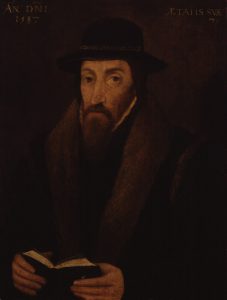 bilious imprint. The suspicion about John Bare’s version is that there are things about Anne’s life with which he was not entirely comfortable. He therefore makes changes to re-position her – taking agency way from her, presenting her as simply a weak tool of God’s work, meek pious, obedient – a victim. Although John Foxe also seems to made some edits, he is generally thought to have done a much better job, and the real Anne emerges from his work. She is well educated, subversive of male authority, brave, witty, and intelligent – and confident of her own salvation.
bilious imprint. The suspicion about John Bare’s version is that there are things about Anne’s life with which he was not entirely comfortable. He therefore makes changes to re-position her – taking agency way from her, presenting her as simply a weak tool of God’s work, meek pious, obedient – a victim. Although John Foxe also seems to made some edits, he is generally thought to have done a much better job, and the real Anne emerges from his work. She is well educated, subversive of male authority, brave, witty, and intelligent – and confident of her own salvation.
When Bale’s work was published, Bishop Gardiner was furious, demanded it be repressed, claimed they misreported events, and also wrote
For if it be persuaded the understanding of Gods law to be at large in women and children, whereby they may have the rule of that, and then God’s law must be the rule of all, is not hereby the rule of all brought into their hands?
Gardiner’s fear was of women empowered not just in religion, but also in politics, and would have struck a cord in many at the time. In the continuing struggle between Catholic and Protestant propaganda, later Catholic authors also used Anne’s independence to discredit her. These are the words of Robert Persons, a Catholic recusant born in 1546 and who died in Rome in 1610.
‘to gad up and down the country a gospelling and gossiping where she might and ought not. And this for divers years before her imprisonment; but especially she delighted to be in London near the court’
Anne’s legacy survived though. In 1673 Bathsua Makin, a tutor in the household of Charles I, called her ‘a person famous for learning and piety‘ and claimed that Askew had ‘so seasoned the Queen and ladies at Court, by her precepts and example, and after sealed her profession with her book, that the seed of reformation seemed to be sowed by her hand’ (Diane Watt, ODNB).
Anne’s Ballad
The work was produced by Anne in Newgate prison. Her intention seems to have been to inspire others to endure persecution through her example.
Like as the armed knight
Appointed to the field,
With this world will I fight
And Faith shall be my shield.
Faith is that weapon strong
Which will not fail at need.
My foes, therefore, among
Therewith will I proceed.
As it is had in strength
And force of Christes way
It will prevail at length
Though all the devils say nay.
Faith in the fathers old
Obtained rightwisness
Which make me very bold
To fear no world’s distress.
I now rejoice in heart
And Hope bid me do so
For Christ will take my part
And ease me of my woe.
Thou saist, lord, who so knock,
To them wilt thou attend.
Undo, therefore, the lock
And thy strong power send.
More enmyes now I have
Than hairs upon my head.
Let them not me deprave
But fight thou in my stead.
On thee my care I cast.
For all their cruel spight
I set not by their haste
For thou art my delight.
I am not she that list
My anchor to let fall
For every drizzling mist
My ship substancial.
Not oft use I to wright
In prose nor yet in rime,
Yet will I shew one sight
That I saw in my time.
I saw a rial throne
Where Justice should have sit
But in her stead was one
Of moody cruel wit.
Absorpt was rightwisness
As of the raging flood
Sathan in his excess
Suct up the guiltless blood.
Then thought I, Jesus lord,
When thou shalt judge us all
Hard is it to record
On these men what will fall.
Yet lord, I thee desire
For that they do to me
Let them not taste the hire
Of their iniquity.
(From the Poetry Foundation)

I am struck with admiration for steadfast bravery. I wonder in this age of over-sensitive, easily offended, self-absorbed youth, if there would be one person with the fortitude and will of this amazing woman.
She is extraordinary; I am utterly convinced I would have been incapable of resisting so much as a broken fingernail.
I love the story of Anne Askew and how she gave up her life to save her friends by not giving the king their names. As a follower of Christ to do that is to be strong in him and what Anne Askew did showed how much she loved and believed in the one true, and only God.
It is very possible God sustained her. He of course has that ability. If you’ve read Foxes book it is not uncommon.
I think Anne Askew is extraordinary, so glad you did a piece on her. I am amazed by people who were able to stand up in the face of being burned at the stake. I really can’t imagine anything I wouldn’t do to avoid being set on fire. I imagine my principles would go out the window in one second if a match was lit in my general vicinity.
Incredible isn’t it? I am with you on this one.
I wish I could I had her courage but I’m a wimp.
Me too, sadly
Hello Anne Askew is my Great great aunt 14th times removed .we are down the line of Edward here brother I live in Stallingborough as will
Obviously the house that Anne grew up in as well gone now .but there’s been a modern building put up in owner of Ann Askew it’s a little block of apartments a bit like flats really named obviously Anne Askews House. I only realised a few years ago that i have a long line of Family all with the surname Askew and most of them have lived round Lincolnshire Louth Grimsby Stallingborough so i put two and two together and started to research my family history with my cousin could not do this alone and yes so it turned out we are related to the famous Anne Askew I still couldn’t believe it so with good old DNA this proves to be right my grandma always said we was related to Ann Askew I never really believed it or took my grandmother seriously I bet she looks down at me and says told you so …………kim
That is quite a connection!
I believe I am also related to her. I can trace my Askew heritage back to Hugh Askew (1565-1600). That is as far as I get. Would you by chance have him in your line?
Hello, I’ve just found this on here. I was just r going to updates and put spelling mistakes right ….anyway you are related as well for sure l… I will come back on here. And show you how anyway I’m going to get some sleep now but when I wake up in the morning well later after doing a nightshift I will contact you on here. Bye for now
I believe we are too. We were also told that we were 14 generations later on than her. Also Askews.
Hello, Anne is my 14 x great grandmother and my absolute hero. We are related through my maternal line.
Kim, you are so lucky to live in Anne’s home town with all it’s history and I’m so happy that her name lives on.
Sorry….typo! Anne is my 12 x great grandmother.
Pls get in touch with me I may have very interesting news for you as I believe Anne was the gt gt aunt of Isaac C Newton whose grandma who brought him up was a Marjorie ayscough another form of Askewe. I am Ruth power. Email Ruth.blyton@gmail.com. Pls contact me. I know other askewes here in Qld aust from your area. My name is Ruth power.
How wonderful that this brave woman’s works survive, what an inspirational person she is. I’m in awe of her fortitude, passion and bravery. I read her ballad in Inspiration Women’s Voices Poetry & Letters and wanted to learn more about her, which led me to your article.
Likewise I’m afraid I would recant all to save my sorry skin.
Thank you for your insight and clarity. Anne’s voice lives on…
Anne Askew was a very brave lady. A reason for her being tortured was to extract names of fellow protestants from her. In particular they wanted to be able to arrest and execute Queen Catherine Parr (last wife of Henry VIII). Parr was a godly woman who helped further the cause of the Gospel in England. Parr is acknowledged as the first woman writer to be published. Her famous book id the Lamentation of a sinner. This book is a “Conversion” narrative – well worth reading.
l was in tears after reading the above, unbelievably brave and steadfast girl, how do you build on to your faith when tied to a stake to be burnt?
“l am not here to deny my faith” wow, l am a Christian but l don’t know if l could stand up for my beliefs like Anne did when faced with that choice. And preaching to the jailers for two hours right after being on the rack.
May she have a mansion in Heaven.
Sorry should read “how do you hold on to your faith”
It is extraordinary isn’t it? And there are so many stories like this, for all kinds of faiths and beliefs. There is now way I could measure up to what she bore.
Thank you for writing this article. I just found out that Anne Askew is my 12th Great Grandmother. I’m so proud to have such an incredibly strong, as well as an ahead-of-her-time feminist ancestor to look up to! I can’t wait to read more about her. Anne’s granddaughter (also named Anne Askew) married into the Clayton family and they both ended up in NJ sometime in the late 1600’s – early 1700’s. It appears as though the family remained in NJ after moving here from England (I live in NJ as well). I’m perplexed as to how Anne has the surname Askew if her husband’s was Kyme?
I think she was Anne Kyme – or at least ODNB says ‘married name Kyme’; for some reaspn she’s just become known in history under her maiden name
Anne Ayscough Kyme is my 13th grandmother. During my recent family ancestry research I came upon her. Reading about Anne’s life story of faith and unwavering strength in God stirred up such a well of emotions for me.
Thank you for remembering and honouring this incredible woman of faith.
England was a frightening place to be, back in her time.
Her love and forgiveness for her enemies, faith in Jesus and extraordinary courage in the face of such terror and torture that she endured for her LORD, puts modern ‘christians’ to shame.. she really knew GOD and is with Him and the angels in Heaven. We can all learn a lot from her example of what it means to be a TRUE follower of JESUS.
May we remember and pray for those who are suffering for their faith in GOD in our modern world.